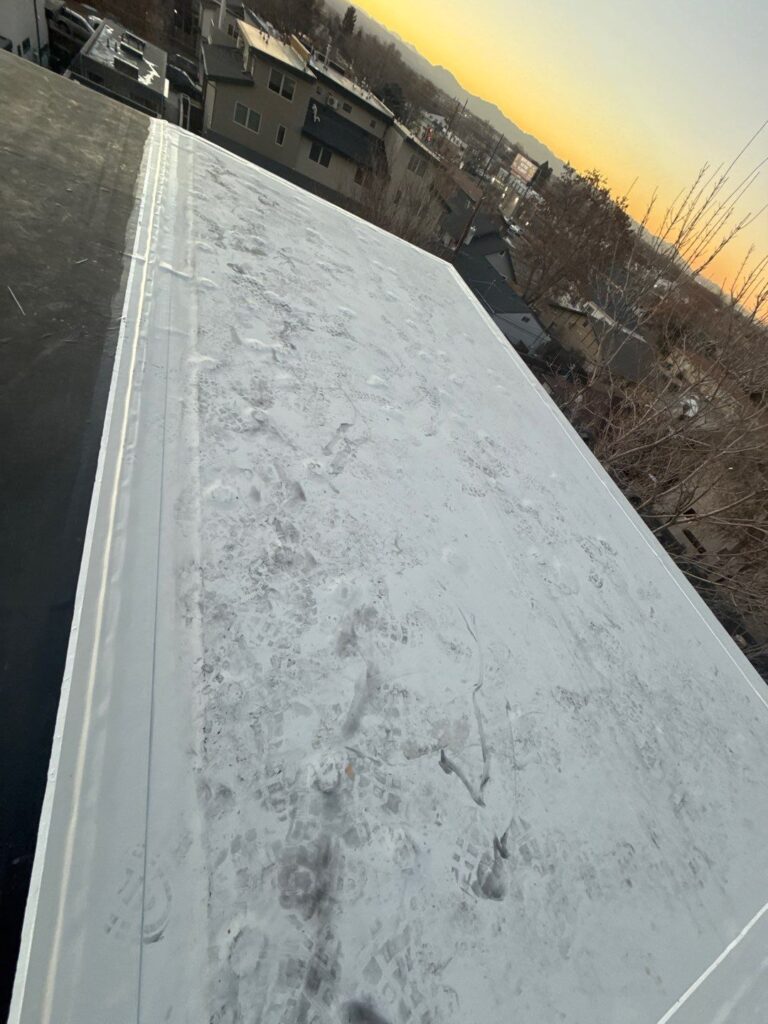
Flat roofs in Denver, Colorado are exposed to one of the most challenging climates for roofing systems. With fluctuating temperatures, heavy snow loads, and freeze-thaw cycles, building owners and facility managers must proactively prepare their flat roofs to withstand winter damage. Without a comprehensive plan, flat roofs are vulnerable to premature deterioration, water infiltration, and expensive structural repairs.
Understanding the Risks: Why Winter is a Critical Time for Flat Roofs
Flat roofs, especially those on commercial properties, face significant winter threats due to their geometry. Snow accumulates more easily on flat surfaces, increasing the chances of:
- Snow and Ice Accumulation: Unlike pitched roofs, flat roofs do not shed snow quickly. Snow loads can linger for weeks, placing stress on the structure and exacerbating drainage issues.
- Freeze-Thaw Expansion: Temperature swings, common in Denver winters, cause roofing materials to expand and contract. These cycles lead to seam separations in membranes like TPO, EPDM, or modified bitumen.
- Ponding Water: Improper drainage or blocked downspouts often results in standing water that accelerates membrane degradation and leads to leaks.
- Membrane Splitting and Microcracks: As temperatures fluctuate between extremes, small cracks form and expand, eventually allowing moisture to penetrate insulation layers and interior spaces.
Critical Maintenance Measures Before the First Snowfall
Preventative winter roofing maintenance is essential for ensuring roof longevity and minimizing emergency repairs. Our roofing experts recommend the following steps as part of your winter readiness strategy:
1. Thorough Roof Inspection
Conduct a detailed inspection before winter begins. This includes checking:
- Flashing for separation or lifting
- Membranes for bubbling, punctures, or blistering
- Drainage systems for blockages or ice dams
- Roof edges for signs of wind damage or thermal shifting
Engaging professional roofers in Denver ensures even minor issues are identified before snow cover conceals them.
2. Debris Removal and Drainage Clearing
Leaves, branches, and other debris trap moisture and create weak spots in the membrane. Downspouts and internal drains should be flushed and tested to prevent water buildup and freeze damage.
3. Sealing and Surface Repairs
Using compatible roofing materials, small cracks and seam splits should be sealed or patched before snow accumulation. Pay special attention to areas where mechanical equipment, skylights, or vents are installed.
Advanced Protection: Applying Fluid Roof Coating Systems
For aging flat roofs that still have structural integrity, fluid-applied roofing systems offer a cost-effective, high-performance solution. These systems are designed to:
- Restore waterproofing layers
- Improve UV resistance
- Increase energy efficiency
- Extend service life without full replacement
Silicone-based coatings, like the Gaco roof system, remain flexible in extreme temperatures and are highly resistant to ponding water — a critical benefit for flat roofs in Denver’s freeze-heavy winters.
Emergency Response Plans for Winter Roof Damage
Even with preparation, winter weather can cause sudden failures. Establishing a winter emergency response plan is essential:
- Keep a Trusted Roofing Company on Call: Work with reliable roofing companies in Denver, Colorado that offer 24/7 emergency services. Time is critical in preventing interior damage.
- Document Roof Conditions: Maintain records and photos of roof conditions before and after storms for warranty or insurance claims.
- Install Snow Guards and Roof Heating Systems: In areas with consistent ice damming, snow retention systems or heating cables can prevent dangerous runoff and structural ice loads.
Budgeting for Long-Term Flat Roof Sustainability
Instead of reacting to failures, proactive budgeting ensures funds are allocated for:
- Bi-annual inspections
- Scheduled surface coating every 8–12 years
- Drainage upgrades
- Reinforcement of high-traffic zones
Tried and True Roofing, a leading roofer in Denver, Colorado, recommends incorporating long-term roof asset management into overall facility planning to reduce unexpected costs and extend roof lifespan.
Conclusion
Protecting a flat roof from Denver’s harsh winters demands preparation, regular inspection, and timely intervention. Property owners and managers who prioritize preventive maintenance and strategic upgrades can avoid catastrophic failures, maintain building integrity, and optimize ROI. With reliable roofing companies in Denver on your side, you can keep your flat roof in peak condition even through the coldest months.

